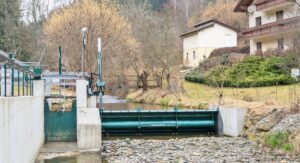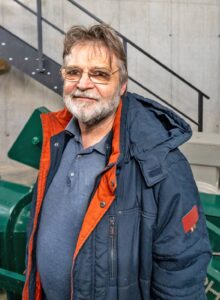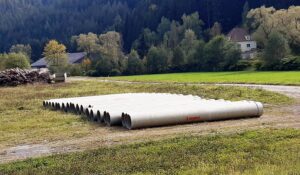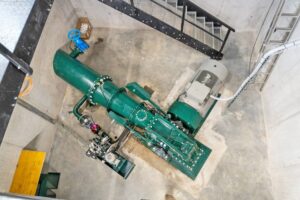Waldbach hydropower plant in Styria goes online with regional expertise
The newly-built Waldbach small hydropower plant in Eastern Styria has now been generating clean electricity for almost two years. Having already overseen the construction of two photovoltaic systems, committed local residents also oversaw the implementation of this small hydropower plant project. The operators at ÖKO Energie RIPO KG are proud to have realised the power plant project largely using regional industry expertise. The centrepiece of the plant is a crossflow turbine with a bottleneck capacity of 110 kW and a standard operating capacity of around 300,000 kWh.

© zek
Joglland in north-east Styria was the home of famous Austrian author Peter Rossegger. Here conditions are ideal for the generating hydroelectric power. The topography is hilly and offers numerous bodies of water. The densely-wooded region stretches across the districts of Hartberg-Fürstenfeld and Weiz, where the power of water has been harnessed for many centuries. For hundreds of years, craftsmen used traditional water wheels to power mechanical transmissions in mills, forges and sawmills. “Once electricity was introduced, increasing numbers of island power stations were built, and commonly shared by several farms. It is said that around 30 small plants operated in the region,” recounts Franz Riegler, Managing Director of ÖKO Energie RIPO KG, the constructors of one of the latest small-scale hydropower plants in the Waldbach-Mönichwald area.

© zek
Renewable prioritised
In his interview with zek HYDRO, Franz Riegler highlights the importance of sustainable power generation in the region, mentioning a whole range of renewable energy sources in use in Waldbach-Mönichwald. A combined heat and power biomass plant is fuelled with local wood to generate electricity and heat. Furthermore, two photovoltaic systems went operational in 2014 and 2016, producing a combined total output of over 500 kWp. Finally, a new small hydropower plant on Weißenbach River went online in the summer of 2022. “We were already considering building a hydropower plant while planning the first photovoltaic system. Construction ultimately began in autumn 2021 after comprehensive consideration of design options,” explained Riegler, emphasising the broad range of conditions that had to be taken into account when designing the plant. “Fortunately, several members of the power plant company are also very talented craftsmen, so we were able to conduct a lot of the work – such as laying the pipes – ourselves. Obviously, this had a positive impact on costs.”

© Riegler
Compact weir system
The Weißenbach River is dammed at the water intake by a hydraulically-operated weir flap. Headwater is channelled to the side inlet on the right – orographically speaking. Subsequently, the water flows from the outlet through the desanding basin, where fine sediments in the water settle. Larger travelling and floating debris is stopped by a fine vertical screen at the rear end of the desander. The screen is cleaned by a hydraulically-operated telescopic cleaning device that removes debris to a flushing channel. The fish ladder is adjacent to the desander basin and was constructed to provide a technical solution. Total residual water discharge is adjusted every three months. Depending on the time of year it ranges between 88 and 104 l/s. Franz Riegler adds that measures were also implemented to improve fish passability in the residual flow section, including the removal of the existing drop steps, and the specific placement of river stones to raise the water level in certain areas. The full range of hydraulic engineering equipment was supplied by the Styrian hydropower experts at Mayrhofer Maschinenbau.

© Riegler
GRP penstock piping
According to Franz Riegler, the largest challenge during the entire project was the installation of almost 1.3-km of pipeline to transport the water downhill. This consisted entirely of glass fibre reinforced plastic (GRP) pipe sections. “Some sections of the pipe routing run close to an existing 20-kV power line – the underground power transmission conduit from a neighbouring wind farm. For this reason, great care was required when laying the pipes. The grid operator was present wherever the medium-voltage line was crossed.” As well as crossing the wind farm power conduit, the penstock also had to traverse multiple items of municipal infrastructure – including sewers and power lines. This task was made easier due to the installation of GRP pipe sections. The piping has proven its worth around the world, as its low weight, compared to much heavier cast iron or steel pipes, makes handling far easier during installation. All pipe material and special fittings were supplied by the expert Upper Austrian distributors Geotrade Tiefbauprodukte GmbH. SUPERLIT piping is lightweight, the material is robust and offers a whole range of advantages – including excellent hydraulic properties, resistance to environmental influences, consistently high abrasion resistance, and very favourable flow properties that minimise frictional resistance. A power cable and a fibre-optic cable were also laid during installation of the GRP penstock to provide for the digital hook-up of the weir system, in turn enabling remote monitoring via video camera.
Highly versatile cross-flow turbine
The centrepiece of the plant is a crossflow turbine with a directly coupled asynchronous generator. The entire machine set was built by the Styrian hydropower all-rounders at Mayrhofer Maschinenbau. The 2-cell turbine provides constant power generation, even when the water supply is greatly reduced. The machine set is designed to process a discharge water volume of 420l/s and a 34-m net head, so at full volume it can generate 110 kW of electrical power. The comprehensive scope of delivery provided by the Styrian industry specialists was rounded off with a full range of electrical equipment and control technology infrastructure. This included automatic plant control with visualisation, remote maintenance access via PC, smartphone and tablet, weir flap and turbine water-level regulation tech, automatic control of the screen cleaning system, and reactive current compensation. The electricity generated is fed onto the public grid through a transformer in the immediate vicinity of the powerhouse run by the grid operator Feistritzwerke.

© zek
In operation for two years
The new building was commissioned in July 2022, a mere ten months or so after the ground-breaking ceremony. Franz Riegler expanded: “Although the technological infrastructure worked perfectly, the initial period of operation did not yield much electricity due to the extremely dry weather over a period of several months. This led to a large-scale restriction of hydropower electricity generation capacity across many borders. Fortunately, precipitation has returned to stable levels again, enabling the power plant to operate normally and generate electricity effectively.” Franz Riegler then pointed out that, additionally, green electricity was being generated by roof-mounted PV infrastructure on the machine building.